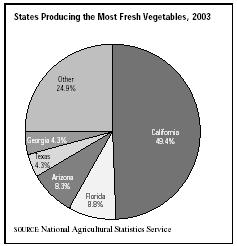SIC 5148
FRESH FRUITS AND VEGETABLES
This industry is comprised of wholesale distributors of fresh fruits and vegetables. It also includes establishments involved in banana ripening for the trade.
NAICS Code(s)
422480 (Fresh Fruit and Vegetable Wholesalers)
In 2001, the U.S. Census Bureau reported a total of 5,753 establishments engaged in the wholesale distribution of fresh fruits and vegetables. In 2003 there were a total of 6,988 establishments and a total of 100,125 employees. The total sales generated were approximately $35.8 billion, with the average sales per establishment totaling about $5.7 million. California led the nation in both number of establishments, with 1,419, and value of sales, with $8.4 billion. Florida ranked second with 793 establishments and sales totaling $10.2 million, followed by New York, Texas, and New Jersey. Most industry establishments were classified as merchant wholesalers, those who take title to the goods they sell. The remaining businesses in the classification are agents, brokers, and commission merchants.
The fresh fruits segment had 1,136 establishments and employed 28,103 people. It accounted for more than 16 percent of the market, with total sales of $10.2 million. Banana ripening numbered 528 establishments, and fresh vegetables had 396 establishments and generated $6.3 million.
Sales of fresh vegetables and fruits in the United States have increased significantly since 1987, due in great part to nutritional awareness and promotions by national dietary-health programs such as "5 A Day—For Better Health." Increased interest in adopting a meatless lifestyle also propelled vegetable sales. By the end of the

century, more than 12 million Americans considered themselves to be vegetarians.
Vegetable production in 1993 declined one percent, attributable to tomato crop damage in Florida and lower sweet potato production, both of which were down eight percent. Grower receipts in 1995 were $14.8 billion—the fifth consecutive increase in receipts and a record high. Strong prices for lettuces, potatoes, carrots and melons supported the higher receipts as did broccoli and watermelon consumption. Production had increased by the end of the decade, resulting in higher wholesaling receipts. Tomato production alone totaled more than $1 billion in 1998.
An ongoing concern for California and Florida tomato growers impacting wholesalers has been the impact of free trade with Mexico. Tomato imports were up 22 percent in 1996. Contentions are that Mexico dumped tomatoes into the market at prices well below market value. The commerce department and the Mexican government reached an agreement in October 1996 in which Mexican tomatoes were agreed to be sold at prices comparable to U. S. products. The United States International Trade Commission discontinued its investigation as a result.
Consumer interest in ethnic foods has encouraged diversity in crops and spurred wholesalers to add variety to the traditional fruits and vegetables they carry. Mediterranean, Southwestern, and Asian cuisine stimulated sales of vegetables such as eggplant, beets, Asian cabbages, jicama, beans, and peppers. Such new interests also helped increase sales.
Citrus was one of the largest product classifications. Tree-ripe fruit of all varieties, which required special handling, helped increase profits for those able to deliver quality produce.
The total value of the vegetable and melon harvested crops totaled $9.67 billion for 2003, up two percent from the 2002 growing season. According to the National Agricultural Statistics Service (NASS), California held the title of the "fresh market state", including 44 percent of the harvested area, 49 percent of production, and 55 percent of the value. Onions, head lettuce, and watermelon accounted for 37 percent of the overall production. Tomatoes, as onions, and head lettuce combined, accounted for 35 percent of the overall value.
Citrus growers' receipts totaled $2.30 billion for the 2002 to 2003 growing season, down 12 percent over the 2002 crops. Florida was in the lead with 74 percent of the total United States citrus produced. California accounted for 23 percent, and Texas and Arizona shared three percent.
Sunkist Growers, Inc. was the largest marketing cooperative in the fruit and vegetable industry and one of the ten largest marketing cooperatives of any kind in the United States. The organization's grower-owners governed the cooperative and provided direction to its subsidiaries and affiliates. Sunkist also had citrus processing facilities, fruit growers' supply warehouses, an asset management service, and a research center. The company was established in 1893 by 60 citrus growers who joined together to improve their ability to deliver products to the marketplace. Bypassing commissioned agents and brokers, they bolstered grower profitability by sharing packing and marketing expenses. More than one hundred years later, Sunkist had more than 6,000 grower-owners in California and Arizona. In 2001, the cooperative generated $993 million in sales. This was an increase of $99 million over 2000 sales of $754 million.
Further Reading
D&B Sales & Marketing Solutions, 2003. Available from http://www.zapdata.com .
Hoover's Company Profiles. April 2004. Available from http://www.hoovers.com .
Sunkist Growers Inc., 2004. Available from http://www.sunkist.com .
U.S. Census Bureau. Statistics of U.S. Businesses 2001. Available from http://www.census.gov/epcd/susb/2001/US421420.HTM .
United States Department of Agriculture. Natural Agricultural Statistics Service. "Citrus Fruits 2003 Summary." September 2003. Available from http://usda.mannlib.cornell.edu/reports/nassr/fruit/zcf—/cfrto903.txt .
——. Vegetables 2002 Summary. January 2002. Available from http://usda.mannlib.cornell.edu/reports/nassr/fruit/pvgbban/vgan0103.txt .
National Agricultural Statistics Service. USDA. "Vegetables." 8 January 2004. Available from http://usda.mannlib.cornell.edu/reports/nassr/fruit/pvg—bban/vgan0104.txt .
Comment about this article, ask questions, or add new information about this topic: